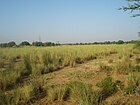Note: This is a project under development. The articles on this wiki are just being initiated and broadly incomplete. You can Help creating new pages.
Difference between revisions of "Saccharum munja - Munja"
| (7 intermediate revisions by 2 users not shown) | |||
| Line 1: | Line 1: | ||
| − | + | [[File:Saccharum munja.JPG|thumb|right|''Munja Grass'']] | |
| − | + | '''Saccharum munja''' known as munja is a grass found in arid areas and along river banks in India. The grass is tall, panicles silky and greenish brown. The grass grows in excess and up to 7 feet in height. Leaf sheath shortly silky at extreme base, otherwise quite smooth, straight, pale straw colored, villous on margins at apex with long white hairs usually much longer than proper internodes, uppermost sheath sometimes extending beyond the base of panicle. | |
==Uses== | ==Uses== | ||
| − | {{Uses|Blood impurity}}, {{Uses|Burning sensation}}, {{Uses| | + | {{Uses|Blood impurity}}, {{Uses|Burning sensation}}, {{Uses|Excess thirst}}, {{Uses|Burning urination}}. |
==Parts Used== | ==Parts Used== | ||
| − | {{Parts Used| | + | {{Parts Used|Roots}}. |
==Chemical Composition== | ==Chemical Composition== | ||
| Line 11: | Line 11: | ||
==Common names== | ==Common names== | ||
| − | {{Common names|sa= |en=Pin red grass|gu=Tirkans|hi=Sarapat|kn= |ks= |ml= |mr= |pa=Munja|ta=Munjipal|te=Mujugaddi}} | + | {{Common names|sa=Munja|en=Pin red grass|gu=Tirkans|hi=Sarapat|kn= |ks= |ml= |mr= |pa=Munja|ta=Munjipal|te=Mujugaddi}} |
==Properties== | ==Properties== | ||
| Line 58: | Line 58: | ||
==Photo Gallery== | ==Photo Gallery== | ||
<gallery class="left" caption="" widths="140px" heights="140px"> | <gallery class="left" caption="" widths="140px" heights="140px"> | ||
| − | + | Saccharum bengalense north Bengal AJTJ.JPG | |
| + | Saccharum munja (2).JPG | ||
| + | Saccharum munja.JPG | ||
</gallery> | </gallery> | ||
| Line 64: | Line 66: | ||
<references> | <references> | ||
| − | <ref name="chemical composition">[https://easyayurveda.com/2017/10/05/saccharum-munja-shara/f | + | <ref name="chemical composition">[https://easyayurveda.com/2017/10/05/saccharum-munja-shara/f Chemical constituents]</ref> |
| − | <ref name="Leaf">[ | + | <ref name="Leaf">[Morphology]</ref> |
| − | <ref name="How to plant/cultivate">[http://tropical.theferns.info/viewtropical.php?id=Saccharum+spontaneum | + | <ref name="How to plant/cultivate">[http://tropical.theferns.info/viewtropical.php?id=Saccharum+spontaneum Cultivation]</ref> |
</references> | </references> | ||
| Line 76: | Line 78: | ||
* [https://www.cabdirect.org/cabdirect/abstract/19912313908 Saccharum munja roxb on cabdirect.org] | * [https://www.cabdirect.org/cabdirect/abstract/19912313908 Saccharum munja roxb on cabdirect.org] | ||
[[Category:Herbs]] | [[Category:Herbs]] | ||
| + | [[Category:Poaceae]] | ||
Latest revision as of 17:18, 31 July 2020
Saccharum munja known as munja is a grass found in arid areas and along river banks in India. The grass is tall, panicles silky and greenish brown. The grass grows in excess and up to 7 feet in height. Leaf sheath shortly silky at extreme base, otherwise quite smooth, straight, pale straw colored, villous on margins at apex with long white hairs usually much longer than proper internodes, uppermost sheath sometimes extending beyond the base of panicle.
Contents
- 1 Uses
- 2 Parts Used
- 3 Chemical Composition
- 4 Common names
- 5 Properties
- 6 Habit
- 7 Identification
- 8 List of Ayurvedic medicine in which the herb is used
- 9 Where to get the saplings
- 10 Mode of Propagation
- 11 How to plant/cultivate
- 12 Commonly seen growing in areas
- 13 Photo Gallery
- 14 References
- 15 External Links
Uses
Blood impurity, Burning sensation, Excess thirst, Burning urination.
Parts Used
Chemical Composition
It contains cellulose, Lignin, Pentosomes and ash.[1]
Common names
| Language | Common name |
|---|---|
| Kannada | |
| Hindi | Sarapat |
| Malayalam | |
| Tamil | Munjipal |
| Telugu | Mujugaddi |
| Marathi | |
| Gujarathi | Tirkans |
| Punjabi | Munja |
| Kashmiri | |
| Sanskrit | Munja |
| English | Pin red grass |
Properties
Reference: Dravya - Substance, Rasa - Taste, Guna - Qualities, Veerya - Potency, Vipaka - Post-digesion effect, Karma - Pharmacological activity, Prabhava - Therepeutics.
Dravya
Rasa
Tikta (Bitter), Kashaya (Astringent)
Guna
Madhura, Tikta
Veerya
Sheeta
Vipaka
Madhura
Karma
Kapha, Vata, Pitta
Prabhava
Habit
Identification
Leaf
| Kind | Shape | Feature |
|---|---|---|
Flower
| Type | Size | Color and composition | Stamen | More information |
|---|---|---|---|---|
Fruit
| Type | Size | Mass | Appearance | Seeds | More information |
|---|---|---|---|---|---|
Other features
List of Ayurvedic medicine in which the herb is used
Where to get the saplings
Mode of Propagation
How to plant/cultivate
A plant of subtropical to tropical areas, where it is found from sea level to 1,700 metres.[3]
Commonly seen growing in areas
Photo Gallery
References
- ↑ Chemical constituents
- ↑ [Morphology]
- ↑ Cultivation
External Links
- Ayurvedic Herbs known to be helpful to treat Blood impurity
- Ayurvedic Herbs known to be helpful to treat Burning sensation
- Ayurvedic Herbs known to be helpful to treat Excess thirst
- Ayurvedic Herbs known to be helpful to treat Burning urination
- Herbs with Roots used in medicine
- Herbs with common name in Hindi
- Herbs with common name in Tamil
- Herbs with common name in Telugu
- Herbs with common name in Gujarathi
- Herbs with common name in Punjabi
- Herbs with common name in Sanskrit
- Herbs with common name in English
- Habit - Perennial
- Index of Plants which can be propagated by Seeds
- Herbs that are commonly seen in the region of River bank
- Herbs that are commonly seen in the region of Wet places
- Herbs
- Poaceae



